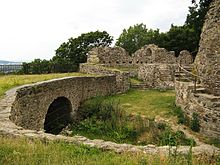world.wikisort.org - Czech
Krupka (Czech pronunciation: [ˈkrupka]; German: Graupen) is a town in Teplice District in the Ústí nad Labem Region of the Czech Republic. It has about 12,000 inhabitants. The town is located in the Ore Mountain Mining Region, an UNESCO World Heritage Site, and during the late Middle Ages it was one of the world-leading producers of tin and silver.[2] The centre of Krupka is well preserved and is protected by law as an urban monument zone.
Krupka | |
|---|---|
Town | |
 Historic centre of Krupka | |
 Flag  Coat of arms | |
 Krupka Location in the Czech Republic | |
| Coordinates: 50°41′4″N 13°51′30″E | |
| Country | |
| Region | Ústí nad Labem |
| District | Teplice |
| First mentioned | 1305 |
| Government | |
| • Mayor | Jan Kuzma (ANO) |
| Area | |
| • Total | 46.61 km2 (18.00 sq mi) |
| Elevation | 300 m (1,000 ft) |
| Population (2022-01-01)[1] | |
| • Total | 12,365 |
| • Density | 270/km2 (690/sq mi) |
| Time zone | UTC+1 (CET) |
| • Summer (DST) | UTC+2 (CEST) |
| Postal code | 417 42 |
| Website | www |
Administrative parts
Town parts and villages of Bohosudov, Fojtovice, Horní Krupka, Maršov, Nové Modlany, Soběchleby, Unčín and Vrchoslav are administrative parts of Krupka.
Etymology
The name "Krupka" was derived from an Old-Czech word krupý, which approximately means "large".
Geography

Krupka is located about 3 kilometres (2 mi) north of Teplice and 11 km (7 mi) east of Ústí nad Labem. The southern part of the municipal territory with the built-up area lies the Most Basin, the northern part lies in the Ore Mountains.
On the southern border of Krupka there is the Kateřina Reservoir, built at the beginning of the 20th century. It was built as part of water management protection, and today it is also used for recreational purposes.[3]
History
The origin of the original mining town is connected with the mining of tin ore and its further processing. The first written mention of Krupka is from 1305 in a deed of King Wenceslaus II. In 1330, existence of a guard fortress is mentioned. After the Hussite Wars, Krupka gained town privileges.[4]
In the 17th century, problems with mining activities began to appear, and tin sales were stuck. The Thirty Years' War adversely affected mining. In 1708, the Clary-Aldringen family purchased the Krupka manor, and owned it until 1918.[4]
In the 19th century, the economic centre moved to neighbouring Bohosudov with the establishment of new factories and lignite mines. In 1858, the railroad to Bohosudov was built. In 1898, Bohosudov was promoted to a town. From 1938 to 1945, Krupka was one of the municipalities in Sudetenland. In 1960, Bohosudov was merged with Krupka and became its most populated town part.[4]
Demographics
|
|
| ||||||||||||||||||||||||||||||||||||||||||||||||||||||
| Source: Censuses[5][6] | ||||||||||||||||||||||||||||||||||||||||||||||||||||||||
Sights


The historic centre of Krupka is made up of Husitská Street, formerly the seat of various craftsmen. Today's appearance of the street consists of rebuilt or reconstructed originally Renaissance houses. The main landmark is the Church of the Assumption of the Virgin Mary from the 14th century. It was destroyed by fires many times and restored in 1668. Behind the church there is a town belltower from the 15th century. Above the church, there is the former town hall, today privately owned.[7]
The Church of the Holy Spirit was built in 1440–1454, originally in the Gothic style. The third church in the street is the Church of Saint Wenceslaus from 1901. Above the street, there is a ruin of Krupka Castle. Only the massive walls have been preserved. It serves as a view point.[7]
The big statue of Saint Francis Xavier belongs to the symbols of the town. It is a Baroque statue from 1717. It was built to commemorate the retreat of the plague.[7]
In connection with the mining, there was created an educational pathway leading from the Czech side to the German side and showing various historically important sites.[8] In Husitská Street, there is the Infocentre of Krupka Mining Region with an exposition focused on history and life in Krupka, mining in Ore Mountains, and ore collection.[9]
Basilica of Our Lady of the Seven Sorrows is the most significant building in Bohosudov. It is a Baroque building from 1701–1706 with pilgrimage tradition.[10]
Notable people
- Carl Ferdinand von Arlt (1812–1887), Austrian ophthalmologist
- Herta Lindner (1920–1943), German resistance fighter
- Radim Breite (born 1989), footballer
Twin towns – sister cities
Krupka is twinned with:[11]
 Geising (Altenberg), Germany
Geising (Altenberg), Germany
References
- "Population of Municipalities – 1 January 2022". Czech Statistical Office. 2022-04-29.
- International Council on Monuments and Sites (13 March 2019). Erzgebirge/Krušnohoří(Germany/Czechia) No 1478 (Report). Retrieved 11 June 2021.
- "Vodní nádrž Kateřina – Krupská pláž" (in Czech). CzechTourism. Retrieved 2022-07-31.
- "Historie města" (in Czech). Město Krupka. Retrieved 2021-07-17.
- "Historický lexikon obcí České republiky 1869–2011 – Okres Teplice" (in Czech). Czech Statistical Office. 2015-12-21. pp. 5–6.
- "Population Census 2021: Population by sex". Public Database. Czech Statistical Office. 2021-03-27.
- "Městská památková zóna - Husitská ulice" (in Czech). Město Krupka. Retrieved 2021-07-17.
- "Turistické trasy, stezky" (in Czech). Město Krupka. Retrieved 2021-07-17.
- "Infocentrum Hornické krajiny Krupka" (in Czech). Město Krupka. Retrieved 2021-07-17.
- "Bazilika Panny Marie Sedmibolestné" (in Czech). Město Krupka. Retrieved 2021-07-17.
- "Spolupráce měst" (in Czech). Město Krupka. Retrieved 2021-07-17.
External links
- Official website (in Czech)
На других языках
[de] Krupka
Krupka (deutsch Graupen) ist eine Stadt im Ústecký kraj in Tschechien. An die historische Bedeutung und Größe der alten Bergstadt erinnert die gut erhaltene Denkmalzone mit Bauten aus der Zeit der Gotik und Renaissance.- [en] Krupka
Другой контент может иметь иную лицензию. Перед использованием материалов сайта WikiSort.org внимательно изучите правила лицензирования конкретных элементов наполнения сайта.
WikiSort.org - проект по пересортировке и дополнению контента Википедии
